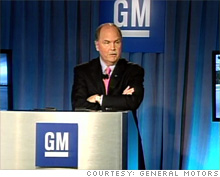'New' GM is born
Automaker closes deal with government. CEO Henderson: 'We'll work hard to repay the trust, and the money, that so many have invested in GM.'
 |
| GM CEO Fritz Henderson said "we'll work hard to repay the trust." |

NEW YORK (CNNMoney.com) -- After a six-week trip through bankruptcy, the "new" General Motors was born Friday owned by the government and free of tens of billions in debt and shed of unaffordable brands, dealerships and plants.
The sale of the valuable assets of the old company to the new GM was completed Friday morning.
"This is an exciting day for General Motors, one that will allow every employee, including me, to get back to the business of designing, building and selling great cars and trucks and serving the needs of our customers," GM Chief Executive Fritz Henderson said.
"We deeply appreciate the support we've received. We'll work hard to repay the trust, and the money, that so many have invested in GM," Henderson added.
But he said he couldn't promise that GM would repay the $50 billion the government has already given or promised to GM.
"Our performance over time will determine if the taxpayers are made whole," he said.
The company hopes to beat a 2015 deadline for repaying about $6.7 billion in government loans, Henderson said.
But Treasury's ability to recover most of the rest of the $50 billion will depend on the future market value of the government's large equity stake. The company's stock is not expected to trade publicly until 2010 at the earliest.
Henderson told CNNMoney Friday that he is confident the company will not need government assistance beyond the $50 billion already committed to its turnaround.
"This is a precious second chance," he said. "There are no third chances."
The new company retains the Chevrolet, Cadillac, GMC and Buick brands, along with most of its overseas operations.
GM also keeps about 3,600 of its 6,000 U.S. dealerships and most of its plants. But 14 U.S. plants will be closed, and the company will eliminate about 20,000 of its 88,000 U.S. employees by the end of the year as it continues to cut costs.
While the new company goes forward outside of bankruptcy, much of its debt and many of the assets it shed in the process remain in bankruptcy. It will take about two to three years for an entity known as Motors Liquidation Co. (GMGMQ) to liquidate under court supervision.
The company is in the process of selling its Saturn, Saab and Hummer brands. It will make its last Pontiac in September. Virtually all of the dealerships it is shedding will continue to sell GM cars and do warranty repair work into 2010, but all are expected to be discontinued by September of next year.
The new GM has a tough road ahead. The company has suffered from decades of market share losses and now accounts for less than 20% of U.S. auto sales. It retains the lead over its rivals such as Toyota Motor (TM) and Ford Motor (F, Fortune 500), although last year it lost its long-time title of world's largest automaker to Toyota.
Despite losing that global sales title, GM's overseas operations are generally stronger than its U.S. operations. Its joint ventures are a leader in sales in China, a growing market that now rivals the U.S. market in sales volume. Only about one in four of its vehicles sold in the first quarter of 2009 were in the United States.
GM has lost $88 billion since 2005 as its debt rose to an unaffordable $54 billion. Its current crisis came as a downturn in the U.S. economy and credit crunch at the end of last year caused industrywide sales to plunge.
The Treasury has pumped about $30 billion into GM to keep it alive since late last year, and will give it an additional $20 billion before the end of 2009. In return, taxpayers will own 60.8% of the company going forward. A trust fund controlled by the United Auto Workers union, which will be used to pay retiree health costs, will hold 17.5% of shares, while the Canadian and Ontario governments will own 11.7%.
The remaining 10% is expected to eventually go to GM's former bondholders as partial compensation for their lost investment in the company. Previous GM shareholders will have no ownership stake in the new company. GM was removed as a component of the Dow Jones industrial average last month following its bankruptcy filing.
On Friday, Henderson started pulling back the curtain on a series of new initiatives.
He announced a proposed new partnership with eBay that will allow buyers in California to bid on vehicles, the way they do for other vehicles. He said the venture would "revolutionize how people buy vehicles online."
GM will also be making announcements later this summer on new battery technology to make electric and plug-in hybrid vehicles possible, Henderson said.
The company announced some key management changes Friday. Vice Chairman Bob Lutz, who had said earlier that he would retire from day-to-day responsibilities, will instead stay with the company to run products and customer relationships.
Customers need to be GM's top priority, Henderson said. "If we don't get this right, nothing else is going to work. It's that simple," he said.
Henderson also announced he was reducing levels of management and several committees that had been responsible for decision making.
"Most people would say our culture to this point has been an impediment and I agree with that," he said.
Have you gone to a state or local government office only to find locked doors due to worker furloughs? Are you a public employee forced to take unpaid time off? How have furloughs affected you? We want to hear your experiences. E-mail your story to realstories@cnnmoney.com and you could be part of an upcoming article. For the CNNMoney.com Comment Policy, click here. ![]()


